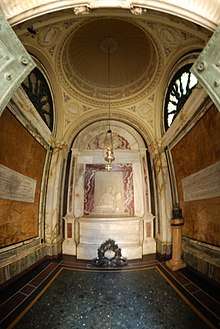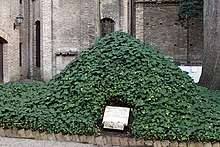Tomb of Dante
.jpg)
The Tomb of Dante (Italian: Sepolcro di Dante) is an Italian neoclassical national monument built over the tomb of the poet Dante Alighieri. It is sited next to the Basilica of San Francesco in central Ravenna[1].
The monument is surrounded by a "zona dantesca", in which visitors have to remain silent and respectful. The small garden to the monument's right originated as the monastic cloister but now only has a colonnade on one side. The garden is traditionally named after the Quadrarco di Braccioforte, where two people invoked the "strong arm" of Christ to guarantee their contract and therefore had the image of that arm painted on the arch[2][3]
History
Burial
Dante had spent his final years in Ravenna and died there in 1321. The day after his death his funeral was held in the cloister of the basilica, then a Franciscan monastery church. He was then buried outside the cloister by the roadside in an ancient Roman sarcophagus, in which he still rests. Bernardo Canaccio wrote a poetic Latin epitaph in 1366, which was inscribed on its lid:
"Iura monarchiae superos Phlegetonta lacusque
lustrando cecini volverunt fata quousque
sed quia pars cessit melioribus hospita castris
actoremque suum petiit felicior astris
hic claudor Dantes patriis extorris ab oris
quem genuit parvi Florentia mater amoris"[4]
The sarcophagus was moved to the west side of the cloister by Bernardo Bembo, Venetian podestà of Ravenna, at the end of the 15th century.
A few years later Dante's hometown of Florence began making requests to have his remains returned. These had the support of two Medici popes, Pope Leo X and Pope Clement VII. The first request was supported by Michelangelo and in 1519 Leo granted Florence permission to move the sarcophagus there, but the Franciscans had enough time to make a hole in the wall and secretly move Dante's bones there. A Tuscan delegation duly arrived but found the sarcophagus empty. It was moved into the cloister and kept under guard.
17th to 19th centuries

Meanwhile the bones were put in a new box in 1677 by Antonio Sarti, prior of the monastery. The sarcophagus was restored under armed guard in 1692. The bones were put back in their original sarcophagus in 1781, the same year as the monument was completed - it had been commissioned from the local architect Camillo Morigia by Luigi Valenti Gonzaga, the cardinal legate in Romagna. Square in plan and with a small cupola and dome, it covers the sarcophagus. Its interior is covered in marble and stucco - Morigia planned to have images of Virgil, Brunetto Latini, Cangrande della Scala and Guido Novello da Polenta in the pendentives of the dome's interior vault, but this plan was abandoned.
Behind the sarcophagus is a 1483 bas-relief by Pietro Lombardo, which also stood in this position for most of the 15th century - it shows Dante reading at a lectern. From the ceiling hangs an 18th century votive lamp, continually kept burning with olive oil from the Tuscan hills donated by Florence ever 14th September, the anniversary of Dante's death. The monument's facade to the street is very simple, with a gate surmounted by Cardinal Gonzaga's archepiscopal coat of arms and the simple inscription "DANTIS POETAE SEPULCRUM" ("tomb of Dante the poet"). The friars hid the bones in the 1677 box again in 1810 during the French occupation to prevent them being confiscated. They walled the box into the nearby oratory of the Braccioforte cloister before leaving the city. Florence had not given up hope of having the remains removed from Ravenna, however, and in 1829 the city erected a cenotaph in Santa Croce Basilica, showing the poet seated in thought and a personification of Poetry weeping over the sarcophagus.

The box's location was forgotten until 27 May 1865, when it was found by a worker carrying out restoration work for the 600th anniversary of Dante's birth. A young student and later a respected notary, Matteucci Anastasio, noticed the words "OSSA DANTIS" (Dante's bones) on the box and saved it from being thrown into a common grave. The bones were rearticulated and put on display to the public in a crystal coffin for a few months before being reburied under the monument in a walnut chest protected by a lead cover.
1900–present
In 1921 a bronze garland was added to the foot of the sarcophagus in memory of the dead of World War One, as well as a marble plaque to its right describing the various restorations of the tomb and an iron gate to the neighbouring garden, designed by the Venetian artist Umberto Bellotto[5]. The bones were hidden yet again during World War Two to prevent them being destroyed by bombing. They were removed from the monument on 23rd March 1944 and reburied in a vegetation-covered mound next to the monument, now marked by a plaque. The bones were put back in the monument on 19th December 1945. The monument was restored in 2006–2007, including a complete repainting of its facades.
References
- ↑ "City website" (in Italian).
- ↑ "Tomba di Dante e Quadrarco di Braccioforte" (in Italian).
- ↑ (in Italian) Passerini, Giuseppe Lando, Minutaglia dantesche, Firenze, S. Lapi, 1911 [1897], ISBN non esistente. via Archive.org.
- ↑ I sang of the duties of a monarch and of visiting the heavens and the Phlegethonian lake / as long as my fates turned / but since my soul left to be a guest in better palaces / and ever more blissfully reached out to its creator's stars / here [is] enclosed [the remains of me,] Dante, exile from his homeland by mouths, / he who was born of Florence, an unloving mother.
- ↑ (in Italian) "Museo Dantesco" (in Italian).
Coordinates: 44°24′58″N 12°12′03″E / 44.41619°N 12.20094°E